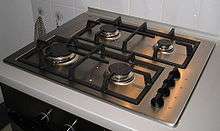Cookbook:Cooktop
Cookbook | Recipes | Ingredients | Cookbook/Equipment
| Appliances

A cooktop, also known as a range or stovetop, is an appliance used for heating pots and pans. Most cooktops are attached to the top of an oven.
Cooktops vary in their methods of heat generation, with some models providing multiple options. The various methods include:
Gas
Gas is traditional and well-loved by many expert cooks. Gas responds quickly to adjustments and generally provides high heat output. Gas works with any pan, including the round-bottomed woks that are best for stir-frying. The flame can be useful for cooking a marshmallow or bell pepper on a fork. Gas cooktops are often very durable. Gas cooktops often come with gas ovens, which are not good for producing crunchy and crispy foods.
Electric Coil
Electric coil cooktops are cheap, common, but don't allow the heat output to be adjusted quickly.
Induction
Induction is the most energy efficient cooktop method which uses magnetic induction energy to produce heat, rather than directly applying heat energy. Induction allows instantaneous heating, which reduces cooking time and reduces room temperatures when compared to other conventional methods. The induction surface is cooler and safer than ceramic cooktops. Induction cooktops have a smooth flat surface that is easy to clean.
Unfortunately, they require flat-bottomed magnetic pots and pans. Aluminum and copper will not work. Stainless steel may work poorly. Cast iron and carbon steel work well.
Induction cooktops now have a significant electronic component integrated in its control and operation. Safety mechanisms such as pan detection, spill detection, temperature sensor - 'safety cutoff' and residual heat indicators (to indicate a surface is hot) are quickly becoming standard features.
Induction cooktops use a tightly-coiled copper tube to direct electrical current, creating a magnetic field that heats only the cookware that it’s touching. This, in turn, heats the food inside the vessel and leaves the rest of the cooktop cool. In fact, without a piece of cookware that is in some way partially composed of iron, an induction cooktop won’t even power up. This creates the one possible flaw to induction cooking, in that you need iron or partially-iron pots and pans to make the systems work. That said, there are circular metal cook plates you can buy that act as a go-between for the cooktop and your cookware, so you might not need to get all new pots and pans after all! You can test the viability of your current cookware by seeing how a heavy magnet reacts to them. If the magnet sticks solidly, then your equipment is good to use with induction devices. If the magnet attracts weakly or not at all, it will likely not work and you’ll need to get a cooking plate or spring for new cookware.
The main criterion of distrust from the part of consumers is the high price of induction cooktops and work mechanism, which is not understood by everyone. It is believed that the magnetic field has a negative impact on human health. But manufacturers argue that the magnetic field, which is created by induction cookers, low and cannot bring harm to the health of people, including those who wear a pacemaker. but it is better to play it safe and stay away from running an induction stove closer than two feet. Or opt out of the use of induction cookers. The allegation that the harm caused by an induction cooker, is not without grounds. It creates a vortex magnetic field. However, the harm is not greater than the harm mobile phones (and they owe more and pressed while talking to the head). The myth of harmful radiation induction cookers – the most popular “horror stories” about this device. Cooked food on the induction cooker is absolutely not radioactive. The eddy currents are generated during operation of the cooking hob is locally limited device housing. Even at a distance of 30 cm from the surface of the plate effect of the field is zero.
Induction cooking has become popular because it offers a lot of benefits such as the following.
Heats Food Quickly: Best induction cooktop heats food faster than any other cooking method. Changes to the temperature take effect immediately. These cooktops come with a lot of safety features. The majority has automatic switches which sense if there is nothing on, and the amount of energy used is reduced. Keeps your kitchen cooler: unlike other cooking methods, it doesn’t spread the heat around, which makes cooking a more comfortable experience.
While induction cooking offers a lot of benefits, there are some potential drawbacks we need to point out.
For an induction cooktop to work, you must have the appropriate cookware. You cannot just use any type as it has to be designed specifically for this. However, this really is not a major issue since a lot of cookware is compatible with induction cooking. Some induction cookers produce a bit of noise, a kind of whirring sound as the built-in fans scatter the heat around. This is normal, but if you hear a clicking sound, it could be indicative there is something wrong with it.
Other features include; electronic touch controls, child safety lock, unsuitable pan detection, preset temperature routines and programs, and power consumption optimization.
Predominant manufacturers include: Kleenmaid, St George, and Whirlpool.
Further Information available at: kitchen cooktops Further Information available at: http://www.kitchenapparatus.com/
Ceramic
Ceramic cooktops act like electric coil cooktops, but they are easy to clean. They are also fragile and expensive.